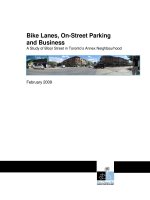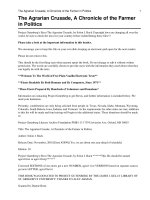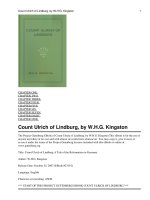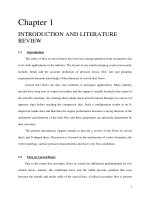A study of the flow in an s shaped duct 6
Bạn đang xem bản rút gọn của tài liệu. Xem và tải ngay bản đầy đủ của tài liệu tại đây (90.7 KB, 12 trang )
69
Chapter 6
FLOW CONTROL IN S-SHAPED DUCT
6.1 Introduction
In previous Chapters, a detailed study was made to highlight the various vortical
structures in S-duct flows. In this Chapter, different flow control techniques are studied to
investigate their effects. It is well known from various studies of S-shaped duct with circular
(Bansod and Bradshaw
(1972)), rectangular (Guo and Seddon (1982)) and square cross sections
(Taylor et al. (1982a), Ng et al. (2006) and Ng et al. (2008))) that such flows are accompanied
by the presence of swirl in the bulk flow and near-wall stream-wise vortices. The optimum
aerodynamic performance of S-shaped ducts (or aircraft air-intake ducts) demands that a
relatively uniform flow with minimal swirl exits the duct and a smallest possible pressure loss.
These requirements naturally lead one to consider the use of traditional flow control devices like
vortex generators, blowing jets, vortex generator jets and fences. Passive devices like vortex
generators placed on the side wall eliminate flow separation if it is present. They “locally” mix
the high-momentum fluid in the free stream with low-momentum fluid near the wall and thus
suppress flow separation. Recent trends show that micro-vortex generators, whose heights are of
the order of boundary layer thickness, are effective devices in flow separation control. These
were discussed in the review paper by Lin (2002).
In contrast to the passive means of flow control, blowing jets and vortex generator jets
are active flow control devices for flow separation control, whereby mass addition near the
separation point energizes the low momentum fluid close to the wall to overcome the adverse
70
pressure gradient. Other devices like zero-net-mass-flux jets and micro-actuators were used in S-
duct for separation control by Mathis et al. (2008) and Hamstra et al. (2000) respectively.
To study the effects of flow control in square cross sectioned S-duct, three different flow
control methods were studied, namely, vortex generator, variable directional tangential blowing
and vortex generator jets. Previous flow control studies are focused primarily on the
aerodynamic improvements in S-shaped duct or diffuser. Less emphasis is placed on whether
competing aerodynamic criteria exist in S-duct flow control, especially one with large curvature.
In this Chapter, this issue is studied by comparing these effects and to weigh the relative merits
of vortex generators, tangential blowing and vortex generator jets on the flow in a square cross-
sectioned S-duct. Suppression of flow separation, reduction of total pressure loss, swirl control
and flow uniformity at duct exit are the four chosen criteria. Quantitative variables like total
pressure loss coefficient, swirl coefficient and distortion coefficient are used to ascertain their
effectiveness. The experimental set-up is explained in the next section.
6.2 Experimental Set-Up
Chapter 2 of this thesis detailed the experimental set-up and instrumentation used in this
flow control work. Only a brief outline of the experiment is given here.
Experiments were conducted in an open loop suction wind tunnel using an
interchangeable S-duct as the test section. The flow velocities were U
m
= 5 m/s and 15 m/s thus
giving a Re, based on hydraulic diameter (D = 0.15 m), of 4.73x10
4
and 1.47x10
5
. Inlet boundary
layer thickness is 7.5 mm or /D = 0.05.
Only Test Section 3 is used here which has an inlet-to-outlet offset of 1.3D with
curvature ratio (R
C
/D) of 1.667 and flow turning angle () of 53.1
O
as shown in Fig. 6.1(a). Test
71
Section 3 is selected from the three test sections because it has the largest turning angle and will
thus pose the most challenge to the various flow control devices evaluated. In reference to the
first turn, the vertical side walls of the duct are labeled as near-side and far-side walls. A row of
36 pressure taps located at mid-height of each vertical side wall is used to measure the wall
pressure distribution. The reference static pressure (P
S
) is measured from the side wall as
indicated in Fig. 6.1(b). Also shown in Fig. 6.1(b) is the coordinate system used in this
experiment. Its origin is at the center of the inlet plane of the S-duct, with the positive s-
coordinate pointing downstream, along the duct centerline.
The total pressure distribution and cross flow velocities at the S-duct exit were measured
with a Pitot-static tube and a rotatable cross wire probe respectively. A linear traversing
mechanism translates the probes at the exit plane both horizontally (y-direction) and vertically (z-
direction) and moves the probes at a spatial interval of 5 mm. Total pressure distribution on the
entire exit plane was measured while for the cross flow velocity, only the lower half of the exit
plane was measured using the cross wire.
Three type of flow control devices were investigated in this study, namely vane-type
vortex generators (VG), tangential blowing, and vortex generators jets (VG jet). Chapter 2
described in detail the set-up of these devices, their respective dimensions, angle of inclination
(
vg
,
blow
and
jet
) and blowing momentum coefficients (C
m
,
SAU
Q
jetm
2
2
2
or
SAU
Q
blowm
2
2
2
= 0.012 and
0.045).
Smoke wire flow visualization was performed on the inner wall of the first bend of the S-
duct to show the presence of flow separation and the effectiveness of flow control devices on
suppressing flow separation. Paraffin oil was coated on three 0.25 mm diameter smoke wires that
stretched across the width of the duct. Smoke streaks formed when the smoke wires were heated
72
by electrical current. The experiment was then repeated to observe the effects of these flow
control devices on suppressing flow separation.
To have a quantitative measure of the aerodynamic performance of S-shaped ducts,
several non-dimensional variables were used. They include the total pressure loss coefficient
(
ω
), swirl coefficient (SC) and distortion coefficient (DC). These definitions are also given in
Seddon and Goldsmith (1999) and Sullerey et al. (2002). The averaged total pressure loss
coefficient (
ω
) was determined by calculating the difference in the averaged total pressure at the
duct inlet and the averaged total pressure at duct outlet, divided by the dynamic pressure. The
swirl coefficient (SC) at the duct exit is defined as the maximum cross flow velocity magnitude
normalized by the mean flow velocity (U
m
). The distortion coefficient (DC) is defined as the
difference between averaged total pressure at the duct exit and the minimum total pressure at the
duct exit divided by the dynamic pressure. These non-dimensional variables are stated as,
ω
=
(6.1)
2
1
2
,,
m
Outlet
AveT
Inlet
AveT
U
PP
ρ
−
SC =
(6.2)
Exit
m
U
v
Max
DC =
(6.3)
2
1
2
,,
m
MinTAveT
U
PP
ρ
−
In the literature, it is common to define the SC and DC for a certain angular sector at the
exit plane for circular cross sectioned S-duct flow. For example SC
60
and DC
60
refer to the
respective coefficients for a 60
O
sector at the exit plane of the duct. In the present investigation, it
73
is more convenient to consider the entire half plane for a square cross-sectioned S-shaped duct
and this provides a better assessment of the aerodynamic performance for such ducts.
In the next section, the effectiveness of these flow control devices on the flow in S-
shaped duct is studied. The results indicate that a conflicting nature exist in which flow control
devices are successful in suppressing flow separation and in reducing total pressure loss but
unable to eliminate stream-wise vortices, to improve flow uniformity, and to attenuate swirling
flow at the S-duct exit.
6.3 Results and Discussion
6.3.1 Flow separation
The effects of the three flow control devices on the side wall C
P
distribution are shown in
Fig. 6.2(a)-(c) for VG, tangential blowing and VG jet respectively at Re = 4.73x10
4
. Fig. 6.3(a)-
(c) show the same but at a higher Re = 1.47x10
5
. C
m
= 0.012 for all these cases that involve
blowing and the C
P
distribution for the bare duct case which had been shown previously is also
shown in each figure for comparison. Without any flow control devices, the C
p
distribution
shows a distinct inflection point on the near-side wall indicating the presence of flow separation.
Next, the flow control devices are installed upstream of the separation point where the near-side
C
p
is a minimum. This location was chosen because downstream of it the adverse pressure
gradient increases and the boundary layer thickens rapidly. With these devices installed, the
relevant C
P
distribution no longer has a point of inflection as indicated in the figures. Hence it
can be concluded that flow separation is suppressed by all three flow control methods at both
Reynolds numbers, and supporting evidences from smoke wire flow visualisation at the lower Re
= 4.73x10
4
are shown in Fig. 6.4(a)-(d). As seen in Fig 6.4, flow separation is present when no
74
flow control devices are installed (Fig. 6.4(a)) and when either VGs, tangential blowing and VG
jets is implemented, flow separation is suppressed as shown in Fig. 6.4(b)-(d) respectively. The
C
P
measurements and flow visualizations show the expected performance of these flow control
devices. In the next sections, the effects of suppressing flow separation on the total pressure loss
in the S-duct will be discussed.
6.3.2 Total Pressure Loss
Using the definition of Sullerey et al. (2002), the averaged total pressure loss coefficient
(
ω
) was determined by calculating the difference in the averaged total pressure at the S-duct
inlet and the averaged total pressure at the S-duct outlet, divided by the dynamic pressure. For
each test, the inclination angle for VG’s, tangential blowing and VG jet was varied and the
corresponding
ω
was measured. The test was also repeated for two different momentum
coefficient (C
m
= 0.012 and 0.045) in tangential blowing and VG jet. Fig. 6.5 and 6.6 summarizes
the variation of
ω
with inclination angle
vg
,
blow,
jet
for VGs, tangential blowing and VG jets at
Re = 4.73x10
4
and 1.47x10
5
respectively. The total pressure loss coefficient for bare duct and the
case for mixed VG configuration are also indicated in the figures.
The figures generally show that there is a reduction in
ω
as
vg
and
blow
increases, thus
implying that the averaged flow rate in the S-duct increases when VGs and tangential blowing
are used. To further optimize the performance of VGs, the mixed VG configuration (as indicated
in Fig. 6.5 and 6.6) led to further reduction of
ω
. For tangential blowing, increasing the blowing
rate from C
m
= 0.012 to C
m
= 0.045 results in lower
ω
at all angles of tangential blowing. This
trend is reversed for VG jet where increased blowing led to an increase in
ω
as shown in both
figures. This is most probably due to the transverse (not tangential) blowing of VG jet into the
75
first bend of the S-duct. The increased momentum that enters the S-duct transversely interacts
with (or disrupts) the main flow and decreases the kinetic energy in the main flow. For effective
flow control using VG jets, there seems to be an optimum blowing rate where the jets roll up into
stream-wise vortex pairs. Flow visualization by injecting smoke created by mixing dry ice with
hot water into the plenum was performed. The vortical structures were illuminated with a light
sheet. This is shown in Fig. 6.7 and in this figure, the free stream flow points out of page. It
shows that the VG jets roll up into counter-rotating vortex pairs at a low blowing rate. This
vortical configuration draws the high momentum fluid from the free stream and mixes with the
low momentum fluid near the curved side wall thereby suppressing flow separation.
The discussion above shows that total pressure loss can be reduced (in most cases
investigated) when flow control devices are present. The reduction in total pressure loss is not
due to the added mass injection for the blowing and VG cases. The mass flow rate ratio (i.e.
mass flow rate of air injection to the mass flow rate in the S-duct) of the various cases can be
computed for tangential blowing and VG jets at both Reynolds number. For both Re, the mass
flow rate ratios for tangential blowing at C
m
= 0.012 and 0.045 are 0.00858 and 0.01665
respectively. Also, the mass flow rate ratios for VG jets at C
m
= 0.012 and 0.045 are 0.0197 and
0.0383 respectively. Hence, the maximum mass flow rate ratio is about 4% with respect to the
bulk flow and for this case, it was shown that VG jets at a high blowing rate "worsen" the total
pressure loss in the S-duct due to the transverse injection of VG jets. For other cases, the mass
flow rate ratio ranges from 0.8% to about 2%. The % reduction in the total pressure loss when
these devices are installed exceeds these percentages. In the next section, the effects flow control
devices on the stream-wise vortices and swirl at the S-duct exit are discussed.
76
6.3.3 Stream-wise Vortices and Exit Swirl
Due to the large number of test cases and for brevity, selected results are used to
highlight the salient features of the effects of flow control on the stream-wise vortices and exit
swirl. The bench mark case is the bare duct where no flow control was used.
Fig. 6.8 and 6.9 show the total pressure distribution and the normalized cross flow
velocity vector plot at the S-duct’s exit for the bare duct case at Re = 4.73x10
4
and 1.47x10
5
respectively. The pictures are drawn such that one is viewing upstream at the S-duct’s exit and
the free-stream flow direction points out of page. Due to flow symmetry, only the normalized
cross flow velocities for the lower half of the S-duct exit are shown. The exit total pressure
coefficient distributions are fairly symmetrical about the z/D = 0.0 plane. There is a relatively
lower total pressure region around the four surrounding walls as compared to the core region. In
addition, the corresponding normalized cross flow velocity plots showed that, in the central
region of the duct, the main bulk of the cross flow is from the far-side wall to the near-side wall
while the cross flow near the bottom floor of the test section is in the opposite direction. A
distinctive swirl is thus present at the S-duct exit plane. At the lower Re = 4.73x10
4
, a vortex can
be seen clearly close to the near-side wall and symmetry plane while a single vortex is noted at
the higher Re = 1.47x10
5
near the bottom corner. The formation mechanism of these stream-wise
vortices was explained qualitatively in Chapter 4 and 5 by making reference to the Squire and
Winter’s (1951) formula. According to Squire and Winter (1951), stream-wise vorticity is
generated in the flow through a duct bend of angle (in radians) when the radial vorticity
s
w
z
u
∂
∂
−
∂
∂
is rotated by . Since the component
s
w
∂
∂
is small, it was ignored in Squire and
Winter’s approximation and they stated that the stream-wise vorticity for a flow after completing
a bend of angle
(in radians), is equal to the velocity gradient
z
u
∂
∂
in the flow multiplied by -
77
2. It was stated in previous Chapters that the initial formation of these stream-wise vortices was
due to the initial swirl generated in the first half of the S-duct. This initial swirl altered the
velocity gradient (
z
u
∂
∂
) close to the near-side wall close to the inflection plane of the S-duct. As
the flow enters the second bend, this velocity gradient results in a redistribution of stream-wise
(or longitudinal) vorticity with the growth and formation of stream-wise vortices.
On installing flow control devices, changes in the configuration of the stream-wise vortex
can be seen in Fig. 6.10(a) to (c) for VG, tangential blowing and VG jets respectively for lower
Re
= 4.73x10
4
while Fig. 6.11(a) to (c) show the same for higher
Re
= 1.47x10
5
. They are angled
at
vg
=
blow
=
jet
= 10
O
with blowing rate at
C
m
= 0.012 for all the cases. It was shown
previously that these devices suppress flow separation and enhance the mixing process. Figs.
6.10 and 6.11 show that this led to a thinner boundary layer at the near-side wall and a slight
improvement in the total pressure distribution especially near the mid height of the near-side
wall. In addition, the normalized cross flow vector plots indicate that they alter the vortex
configuration, position and size of the near-wall stream-wise vortices. For example, the single
vortex near the symmetry plane for the bare duct case (Fig. 6.8) was altered to a pair of counter-
rotating vortices when VGs were installed (Fig. 6.10(a)), to a single large vortex closer to the
bottom wall of the duct when tangential blowing was used (Fig. 6.10(b)) and to a single smaller
vortex when VG jets were used (Fig. 6.10(c)).
The total pressure loss data presented in the previous section shows that the flow in the S-
duct can be further optimized by adopting the “mixed” VG configuration or by blowing at a
higher
C
m
for tangential blowing. These results are shown in Fig. 6.12 and 6.13 respectively for
lower
Re
= 4.73x10
4
. For mixed VG configuration, Fig. 6.12 shows that there is a slight increase
in total pressure coefficient near the
z/D
= 0.0 plane when compared to the corresponding plot in
78
Fig. 6.10(a) where VGs of constant angle
vg
= 10
O
were used. In addition, there is a slight
reduction in size for counter-rotating vortex pair at the corner. It would seem to indicate that the
VGs placed at 20
O
near the corner while keeping the rest at 10
O
led to further mixing near the
corners of the S-duct which results in a relatively higher axial flow velocity near that region as
compared to VGs placed at constant 10
O
incidence. For Fig. 6.13, tangential blowing at a higher
C
m
= 0.045 results in further increases in total pressure coefficient near the corners of the S-duct
as depicted by the general absence of contour lines near that wall and corner. The stream-wise
vortices are generally deflected towards the top and bottom wall of the duct.
The above data show conclusively that the use of flow control devices will change the
configuration, size and position of the stream-wise vortices, depending on the devices’ operating
parameters. In addition, these devices affect the cross flow magnitude at the S-duct exit. To
quantify the swirl flow at these Reynolds numbers, a plot of the normalized
v-
velocity
(horizontal velocity) at
y/D
= 0.0 (midway vertical plane) on the S-duct exit is shown in Fig. 6.14
and 6.15 for the low and high
Re
cases respectively. The figures show the variation of the
velocity’s profile with
z/D
. Also, the swirl coefficient (
SC
) is stated for each case in these
figures. When
vg
=
blow
=
jet
= 10
O
and the tangential blowing and VG jet has
C
m
= 0.012 and
0.045, the effects of using vortex generators, tangential blowing and VG jets on the swirl flow
can be clearly seen in Fig. 6.14 and 6.15 by comparing them to the bare duct case where these
devices were not implemented. With the use of flow control devices, the magnitude of the cross
flow mostly increases as indicated in the figures. When flow control devices are not present, the
cross flow velocity is distinctively lower in magnitude especially in the region nearer to the
horizontal plane of symmetry (
z/D
= 0.0). The installation of any flow control device therefore
also increases the magnitude of
SC
when compared to the bare duct case.
79
In the previous section, it was shown that flow control devices are effective in
suppressing flow separation and reducing total pressure loss. However, it is shown here that this
is accompanied by an increase in swirl which is generally considered as a detrimental effect. The
increase in swirl magnitude is related to the absence of the inflection point in the near side wall
C
p
distribution which in turn increased the radial pressure difference between the side walls on
the S-duct when flow control devices are present. This increase in radial pressure difference can
be appreciated visually in the
C
p
plots of Fig. 6.2(a)-(c) and Fig. 6.3 (a)-(c) for the respective
Re
cases, where the use of flow control devices results in an increased radial pressure difference
which drives a stronger swirling flow in both the first and second bend of the S-duct. To show
this increase in radial pressure difference, the variation of
C
p
, defined as the difference in
C
p
between the far-side and near-side wall, along the S-duct’s normalized centerline distance,
s/D
is
plotted. For brevity, the variation of
C
p
is shown for three cases, namely VG at
vg
=10
O
,
tangential blowing and VG jets with
blow
=
jet
=10
O
and
C
m
= 0.012 and compare these to the
bare duct case when these devices are absent for
Re
= 4.73x10
4
(in Figs. 6.16(a)-(c)) and
Re
=
1.47x10
5
(in Figs. 6.17(a)-(c)). As noted in these figures, there is an increase in magnitude of
C
p
in the first and second bend of the S-duct when VG, tangential blowing and VG jets are
implemented. Since a larger radial pressure difference between the side walls drives a larger
cross flow in the S-duct, this explains the increased swirl at the exit plane that was measured
when flow control devices were used.
6.4 Chapter Conclusion
The effectiveness of VGs, tangential blowing and VG jets to control flow separation,
reduce total pressure loss in a constant area, square cross sectioned S-duct were investigated. The
80
three methods were shown to be effective in suppressing flow separation and reducing total
pressure loss but seem to be ineffective in attenuating the swirl magnitude in the S-duct. In fact,
the three methods increase the swirl in the S-duct. With these devices implemented, the radial
pressure difference between the side walls increases, resulting in a stronger swirl in the S-duct.
Using total pressure and cross flow measurements, it was shown that this increase in radial
pressure difference was due to the elimination of flow separation in the first bend and the
changes in vortical configuration and position of stream-wise vortices on the outer wall of the
second bend in the S-duct. The data therefore indicates competing parameters for improving the
performance of flow in S-ducts.









